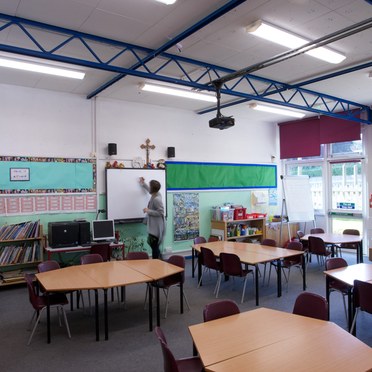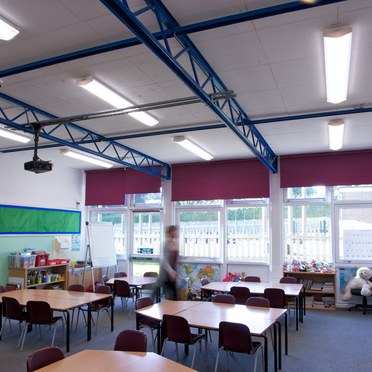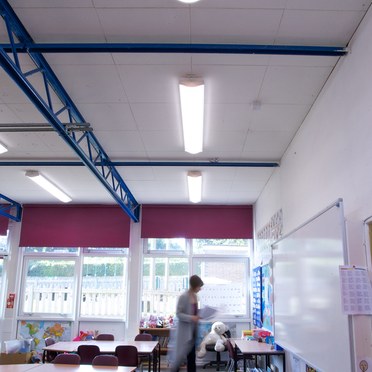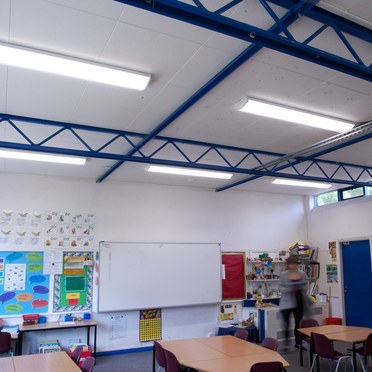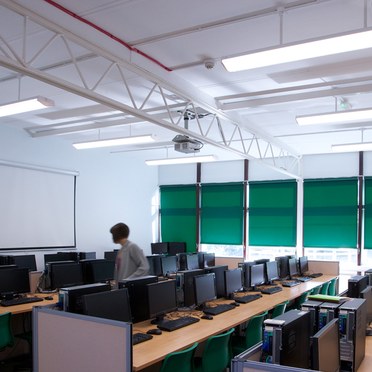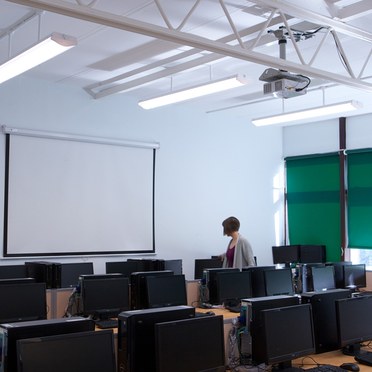Our Lady’s Primary School, Buckinghamshire, UK
- Lamp efficacy
Lamp efficacy
High efficacy LED light sources convert energy more efficiently into light, reducing energy consumption.
- Ballast classification
Ballast classification
Controlling the electricity supply to the lamp (Energy Efficiency Index).
- Luminaire distribution
Luminaire distribution
The use of a luminaire that provides the correct lighting to all relevant surfaces removes the need for additional luminaires for wall-washing.
- System efficacy
System efficacy
Combining optical and thermal control within the luminaire (luminaire lm/W).
- Presence/absence detection
Presence/absence detection
Integral presence sensors within Leopard LED and Novaline LED ensure lighting is only on when required, helping to reduce waste energy.
- Daylight detection
Daylight detection
Artificial lighting which responds to the natural light conditions.
- Constant illuminance
Constant illuminance
A function designed to produce correct light levels for the duration of the maintenance period.
- Task-scene setting
Task-scene setting
Allowing the user to set scenes and adapt the lighting to different tasks.
- Timed off
Timed off
Automatic cut-off can be installed to turn all lights off during unoccupied hours.
- Task lighting
Task lighting
Lighting task areas with the correct amount of light.
- Zoning of lighting
Zoning of lighting
Lighting is zoned according to area use.
- Maintenance schedule
Maintenance schedule
Maintenance must be performed in response to product age, performance and environment.
- Waste light
Waste light
Eliminating waste light which does not hit the intended target.
- Reflectance
Reflectance
Taking advantage of light which is reflected from the surface within the space.
- Visible smart metering
Visible smart metering
Results of actions can be quickly seen as increased or decreased energy use to encourage responsible energy consumption.
Our Lady's Primary School switches to LED
Our Lady’s Primary School in Buckinghamshire, England, has just over 200 pupils, including boys and girls aged between 4 to 11. The school is housed in modern and airy buildings, and the children are taught in seven classrooms by year group. As well as a multi-purpose hall, ICT suite and music room, the school has an outside learning area, grassed area and two play grounds.
With the school closed for six weeks during the 2013 summer holiday period, the board took the opportunity to upgrade all the classrooms, corridors and store areas to LED lighting. The main aim was to improve the lit environment within the school's classrooms. Reducing maintenance and energy consumption were also high priorities.
The classrooms each saw the replacement of nine 1x65W T12 switch start battens with Thorn's latest College LED luminaire. The College LED luminaire is specifically designed for educational environments and has luminaire optics that improve the vertical and cylindrical illuminance within the space to aid communication. College LED's excellent cylindrical illuminance means teachers and pupils can now clearly see and understand facial expressions. The classrooms also feel much brighter with light levels increasing from 200-250lux to more than 400lux, making the space an enjoyable place to learn.
As well as the classrooms, College LED has replaced the dull and uninviting 1x36W T12 switch start corridor battens, transforming the area into a bright and vibrant space. In the storerooms, Thorn's Leopard LED and Novaline LED bulkhead luminaires have replaced the 60W GLS pendants. With integral presence controls, these luminaires ensure the lights are turned off when the space is not in use.
A key benefit of the LED upgrade to Our Lady's School is the reduction in maintenance. With the College LED luminaire offering a lifetime of 50,000 hours, the school can expect the luminaires to last in excess of 20 years while still maintaining at least 70% of the current light output.
Equally important, the move to LED lighting has reduced energy consumption by 39%, saving £560 and 3.33 tonnes of CO2 per annum.
Key Facts
39% energy saving
3.33 tonnes/annum CO2 saving
£560/annum cost saving

